Art World
Luam Melake Makes Intellectual Furniture That’s Vibrant and Squishy
Luam Melake creates colorful, tactile furniture focused on human interaction and emotional connection, challenging the impact of technology and mass production in design.
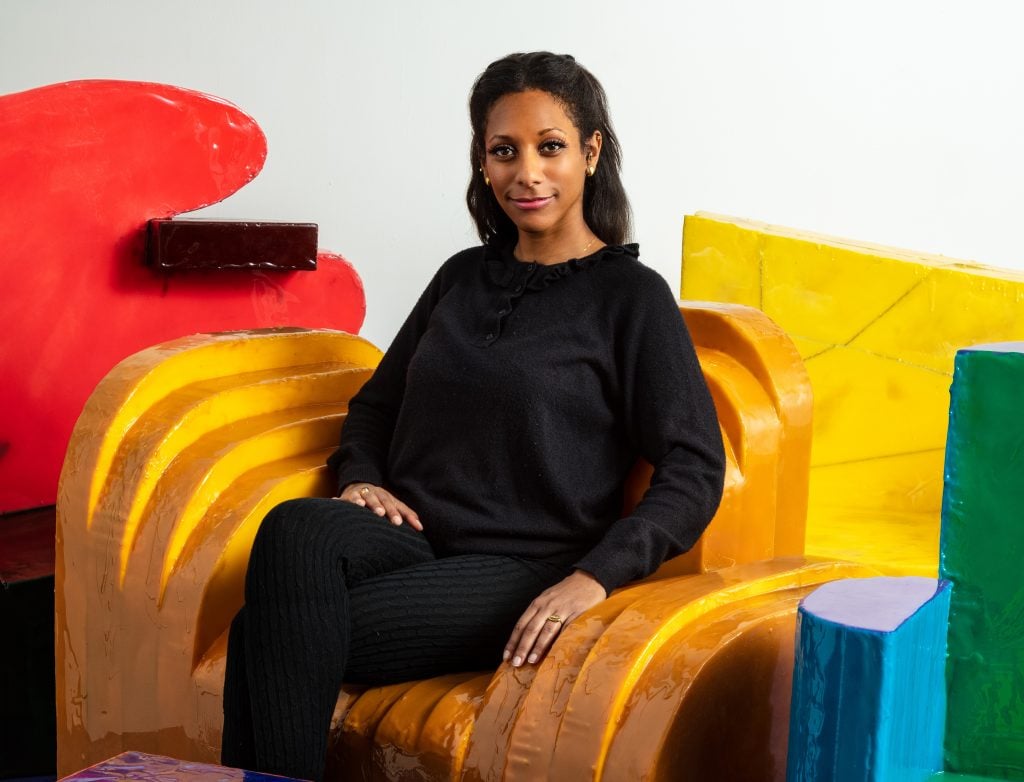
Luam Melake creates irresistible furniture that is brashly colorful and joyous, a luxury design version of children’s toy blocks. At a glance, her pieces look structured to the point of being hard, but a quick squeeze will reveal that their texture is just as fun as their aesthetic. Yes, they are squishy.
“Surprise is an important part of my work,” Melake said earlier this month in her Harlem apartment. “When people see something and think they understand it, they don’t explore it. This is about exploration.” It’s also an example of the way Melake—who is a polymathic creator, approaches her work with an artist’s mind. “I was thinking of how to make soft furniture without using upholstery,” she said. The seating might look childlike and exuberant, but it comes from a serious place. Underneath those candy hues are some brutalist shapes and very big ideas.
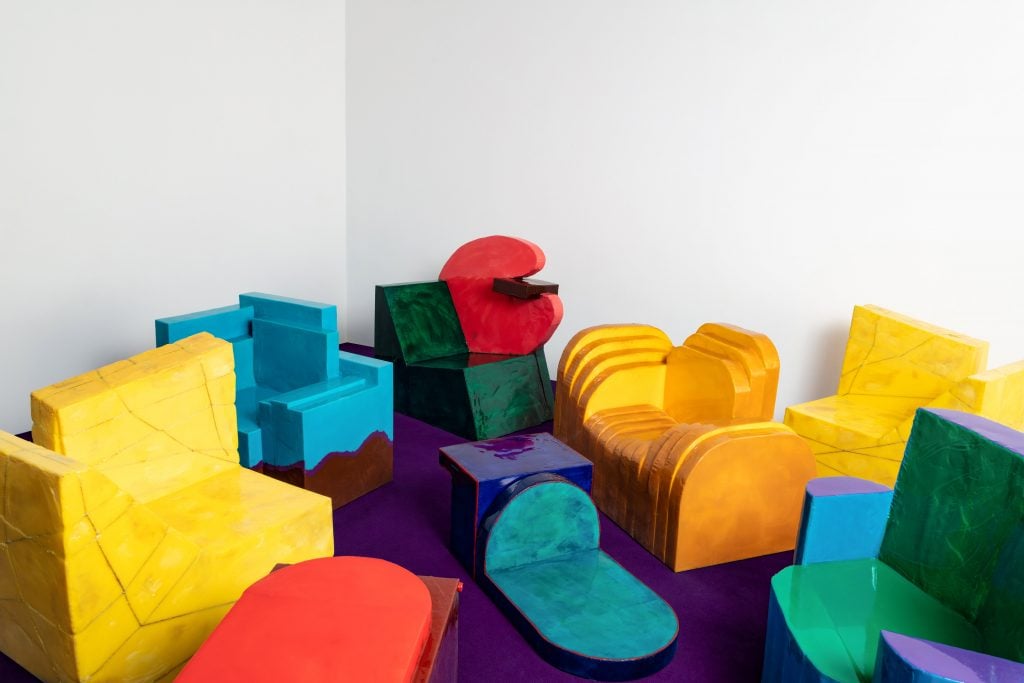
A selection of Luam Melake’s creations. Photo: Joe Kramm. Courtesy the artist and R & Company
“How do I do something creative that’s going to affect people?” the artist and designer says about what drives her unique vision. Melake’s explained that her designs are about the ways in which human beings relate to one another, and how furniture helps facilitate those bodily interactions, but it’s also about, among other things, the alienating effects of technology and the ways in which capitalism is a barrier to innovative design.
Melake grew up in San Diego. Her father was a park planner and her mother was a civil engineer, so she always understood that there was a direct connection between our physical environments and the way we live. Melake studied architecture at UC Berkeley and loved the conceptual aspects of her studies, but was less charmed by the ideas of collaboration and the practical constraints of constructing a large-scale project, such as a building. “I like doing my own thing,” she said. Melake’s own creations filled the living room and her home workshop. She mixed it in with covetous pieces like an undulating Verner Panton chair and a woven artwork by Ed Rossbach (Melake is also a textile artist, her specialty is weaving). “But what I liked about architecture is that it’s structural, it’s something people live with, and it’s more direct than an artwork—it’s not just for contemplation.” Furniture, thus, felt like an easy transition.
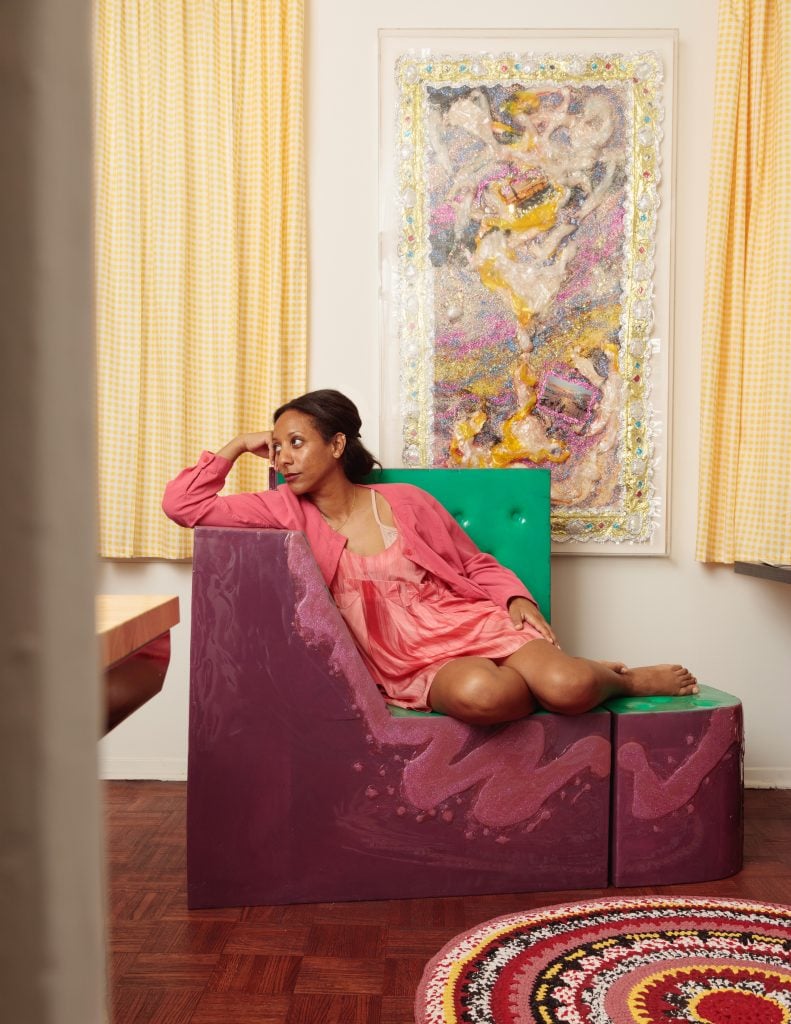
Luam Melake in her apartment. Photo: Logan Jackson. Courtesy of R & Company.
An emblematic piece of her oeuvre can be found in the Love Seat in Two Parts, currently on view at the Tribeca design gallery R & Company’s impressive triennial show Objects USA: 2024 (the Female Design Counsel presented her work at the buzzy inaugural Collectible design fair earlier this month, as well). The modular sofa can be arranged as a singular unit, like a traditional loveseat, or separated into halves, creating two chairs that can be arranged in a variety of ways. Made from sculpted polyurethane foam then covered in a gloopy urethane that gives it a tough, pliable “skin.” The one on display at R & Company is green and purple—a combination somewhat reminiscent of the children’s entertainer Barney the Dinosaur—and covered in whimsical decoration such as glitter and buttons.
“It’s based on proxemics,” says Melake who, on the day we meet, is wearing all shades of pink, right down to her toenail polish. She’s referring to studies that chart the amount of distance two humans require between them to feel comfortable. “It’s also about eye contact, because you can be upright or reclining. There’s a lot of different ways to interact.” Melake’s physical design work is often preceded by a period of research—her home is filled with crammed yet orderly bookshelves.
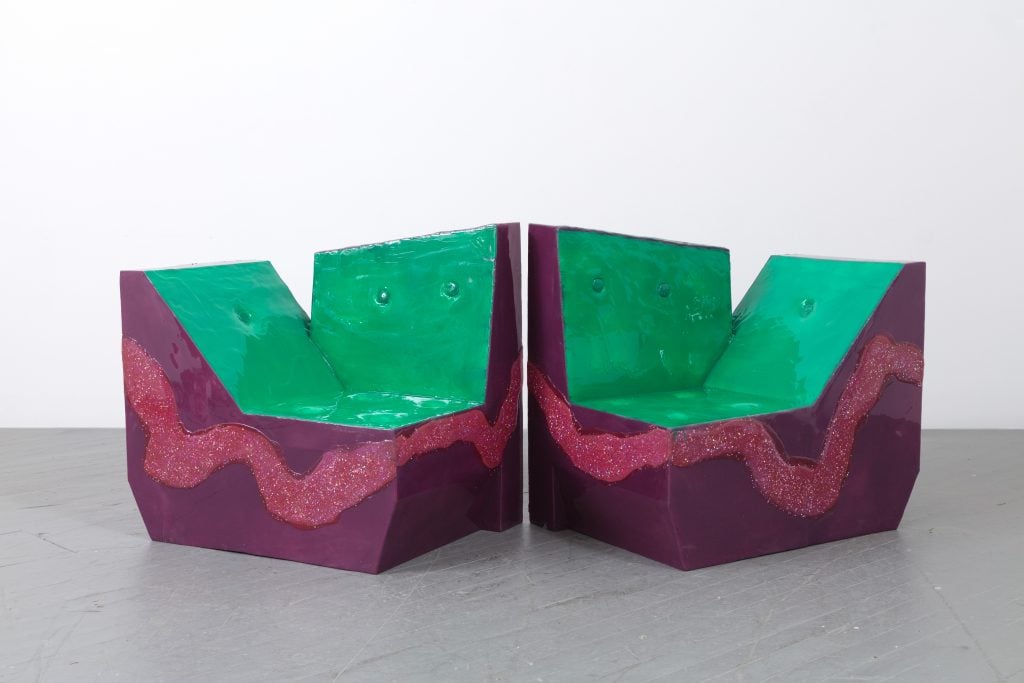
Luam Melake, Love Seat in Two Parts (2024), Urethane, dyes, glitter, buttons, and polyurethane foam. Courtesy of R & Company.
The love seat, for example, was inspired, in part, by ways that adolescents tend to avoid eye contact during difficult conversations, and the bodily arrangement Freud created around this psychology practice, with the patient reclining as he sat upright. “It’s not about the shape, it’s about the interaction,” Melake adds. “Sometimes it’s based in research, but it can be more intuitive.”
Another area of interest, for her, is the post-war period, when America used technology to fuel innovation. “The State Department literally sponsored shows at MoMA, of new, cool design,” she marveled, as she draped herself across one of her in-process pieces. It was a time that the government actually leveraged technology to spur innovation, using all the new materials and production facilities to help build a vibrant middle class. Today, that sentiment is lost to capitalism, where profits supersede creativity. Thus a mass market industry that priorities one-size-fits-all, anodyne output. “I was reading this article by Donald Judd,” she said, “called ‘It’s Hard to Find a Good Lamp’ about how mass production makes innovation impossible. Design is supposed to be innovative! If design isn’t changing, how are our politics going to change?” Melake, it should be said, has no qualms about bringing her sensibility to a broader audience through partnerships. “I’m putting it out there,” she says with a smile. “I will do this for mass market!”
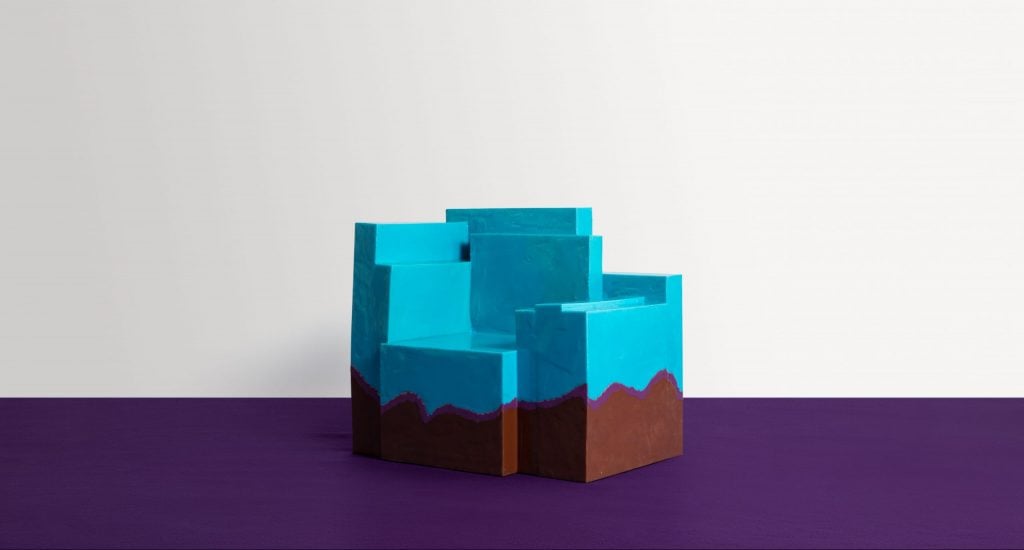
A chair by Luam Meleke. Photo: Joe Kramm. Courtesy the artist and R & Company
“This” includes pieces like her blocky Listening Chair (2022), shaped like a cartoonish city skyline and meant to be sat in or draped across, the body being scooped up as if it were in the palm of some giant’s hand. Or the Supportive Chair (2021), a winged seatback set on top of a half-circle, inspired by Melake reading news stories about the exhaustive toll of motherhood. “It’s like a skirt with crutches,” she offered. She then demonstrated how it’s to be sat in, with one’s head thrown back and chest flung open before letting out a loud, frustrated sigh. “That activates your parasympathetic nervous system,” she said, somewhat cheerily. “So it actually calms you down.”
Currently in her home, she had two new works, which were inspired about themes that repeated, over time, in furniture design. Also are her own woven art pieces (including one made of wave-like nets of telephone wire, another technology reference), juxtaposed with a very analogue foil and glitter explosion of a piece by artist Thomas Lanigan-Schmidt, hanging on a nearby wall.
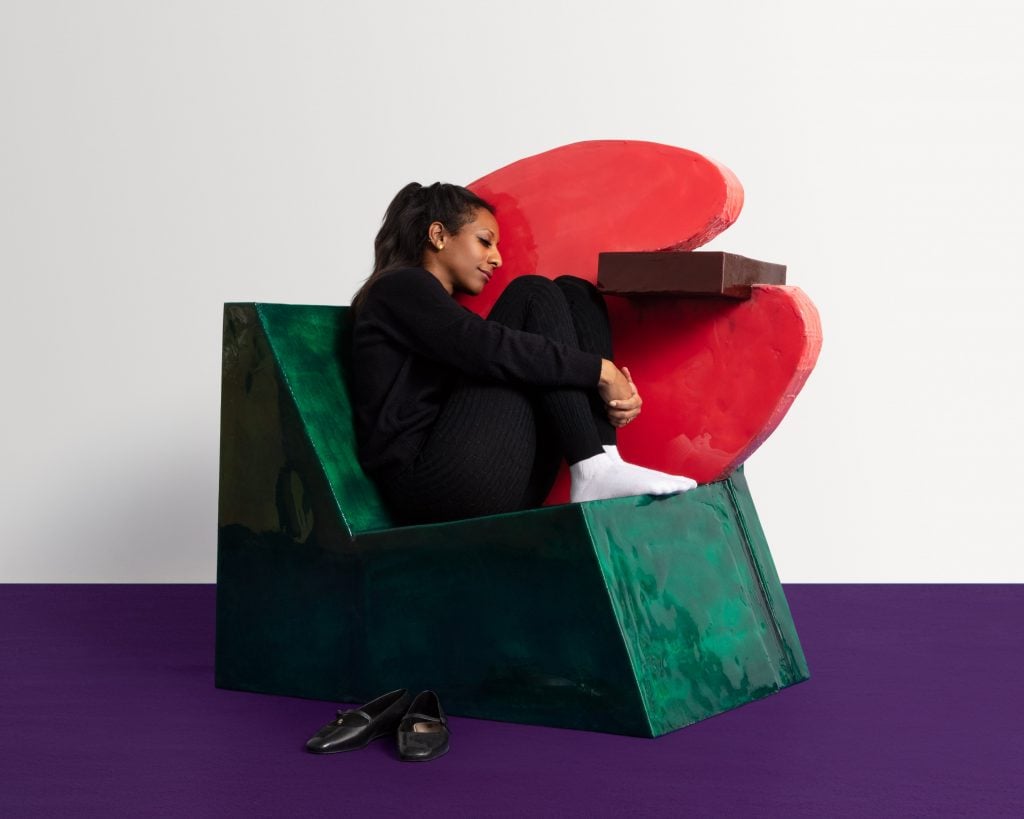
Melake curls up on one of her creations. Photo: Joe Kramm. Courtesy the artist and R & Company
At the heart of Meleke’s work is a desire for human connection, one that is a direct response to the technological age. “My work is about empathy and freedom,” she says. “I’m always thinking We need to be more free. How do we become more free? But tech is taking away our agency. It’s designed to get us addicted, to take our attention. And attention is the solution to loneliness. We need to give our attention to other people, and when you don’t, that’s when the social order breaks down.”
So her response is to make objects that viscerally exist in real life, not digital realms. With their brash colors, playful tactility, and their craggy and wobbly execution, her work resists the sleek, clean and, frankly, dulling aesthetics of the digital age. “We don’t need to design out of this through technology,” Melake said, surrounded by her whimsical, strange, and alluring creations that beg to be touched. “We need to think through it as human beings.”





